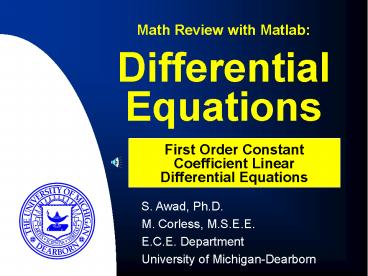S. Awad, Ph.D. - PowerPoint PPT Presentation
Title:
S. Awad, Ph.D.
Description:
Math Review with Matlab: Differential Equations First Order Constant Coefficient Linear Differential Equations S. Awad, Ph.D. M. Corless, M.S.E.E. – PowerPoint PPT presentation
Number of Views:163
Avg rating:3.0/5.0
Title: S. Awad, Ph.D.
1
Differential Equations
Math Review with Matlab
First Order Constant Coefficient Linear
Differential Equations
- S. Awad, Ph.D.
- M. Corless, M.S.E.E.
- E.C.E. Department
- University of Michigan-Dearborn
2
First Order Constant Coefficient Linear
Differential Equations
- First Order Differential Equations
- General Solution of a First Order Constant
Coefficient Differential Equation - Electrical Applications
- RC Application Example
3
First Order D.E.
- A General First Order Linear Constant Coefficient
Differential Equation of x(t) has the form
- Where a is a constant and the function f(t) is
given
4
Properties
- A General First Order Linear Constant Coefficient
DE of x(t) has the properties
- The DE is a linear combination of x(t) and its
derivative - x(t) and its derivative are multiplied by
constants
- There are no cross products
- In general the coefficient of dx/dt is normalized
to 1
5
Fundamental Theorem
- A fundamental theorem of differential equations
states that given a differential equation of the
form below where x(t)xp(t) is any solution to
SOLUTION
- and x(t)xc(t) is any solution to the homogenous
equation
SOLUTION
- Then x(t) xp(t)xc(t) is also a solution to the
original DE
SOLUTION
6
f(t) Constant Solution
- If f(t) b (some constant) the general solution
to the differential equation consists of two
parts that are obtained by solving the two
equations
xp(t) Particular Integral Solution
xc(t) Complementary Solution
7
Particular Integral Solution
- Since the right-hand side is a constant, it is
reasonable to assume that xp(t) must also be a
constant
- Substituting yields
8
Complementary Solution
- To solve for xc(t) rearrange terms
- Which is equivalent to
- Integrating both sides
- Taking the exponential of both sides
- Resulting in
9
First Order Solution Summary
- A General First-Order Constant Coefficient
Differential Equation of the form
a and b are constants
- Has a General Solution of the form
K1 and K2 are constants
10
Particular and Complementary Solutions
Particular Integral Solution
Complementary Solution
11
Determining K1 and K2
- In certain applications it may be possible to
directly determine the constants K1 and K2
- The first relationship can be seen by evaluating
for t0
- The second by taking the limit as t approaches
infinity
12
Solution Summary
- By rearranging terms, we see that given
particular conditions, the solution to
a and b are constants
- Takes the form
13
Electrical Applications
- Basic electrical elements such as resistors (R),
capacitors (C), and inductors (L) are defined by
their voltage and current relationships
- A Resistor has a linear relationship between
voltage and current governed by Ohms Law
14
Capacitors and Inductors
- A first-order differential equation is used to
describe electrical circuits containing a single
memory storage elements like a capacitors or
inductor
- The current and voltage relationship for a
capacitor C is given by
- The current and voltage relationship for an
inductor L is given by
15
RC Application Example
- Example For the circuit below, determine an
equation for the voltage across the capacitor for
tgt0. Assume that the capacitor is initially
discharged and the switch closes at time t0
16
Plan of Attack
- Write a first-order differential equation for the
circuit for time tgt0 - The solution will be of the form K1K2e-at
- These constants can be found by
- Determining a
- Determining vc(0)
- Determining vc()
- Finally graph the resulting vc(t)
17
Equation for t gt 0
- Kirchhoffs Voltage Law (KVL) states that the sum
of the voltages around a closed loop must equal
zero
- Ohms Law states that the voltage across a
resistor is directly proportional to the current
through it, VIR
- Use KVL and Ohms Law to write an equation
describing the circuit after the switch closes
18
Differential Equation
- Since we want to solve for vc(t), write the
differential equation for the circuit in terms of
vc(t)
- Replace i Cdv/dt for capacitor current voltage
relationship
- Rearrange terms to put DE in Standard Form
19
General Solution
- The solution will now take the standard form
- a can be directly determined
- K1 and K2 depend on vc(0) and vc()
20
Initial Condition
- A physical property of a capacitor is that
voltage cannot change instantaneously across it
- Therefore voltage is a continuous function of
time and the limit as t approaches 0 from the
right vc(0-) is the same as t approaching from
the left vc(0)
- Before the switch closes, the capacitor was
initially discharged, therefore
- Substituting gives
21
Steady State Condition
- As t approaches infinity, the capacitor will
fully charge to the source VDC voltage
- No current will flow in the circuit because there
will be no potential difference across the
resistor, vR() 0 V
22
Solve Differential Equation
- Now solve for K1 and K2
- Replace to solve differential equation for vc(t)
23
Time Constant
- When analyzing electrical circuits the constant
1/a is called the Time Constant t
K1 Steady State Solution
t Time Constant
- The time constant determines the rate at which
the decaying exponential goes to zero
- Hence the time constant determines how long it
takes to reach the steady state constant value of
K1
24
Plot Capacitor Voltage
- For First-order RC circuits the Time Constant t
1/RC
25
Summary
- Discussed general form of a first order constant
coefficient differential equation
- Proved general solution to a first order constant
coefficient differential equation
- Applied general solution to analyze a resistor
and capacitor electrical circuit































